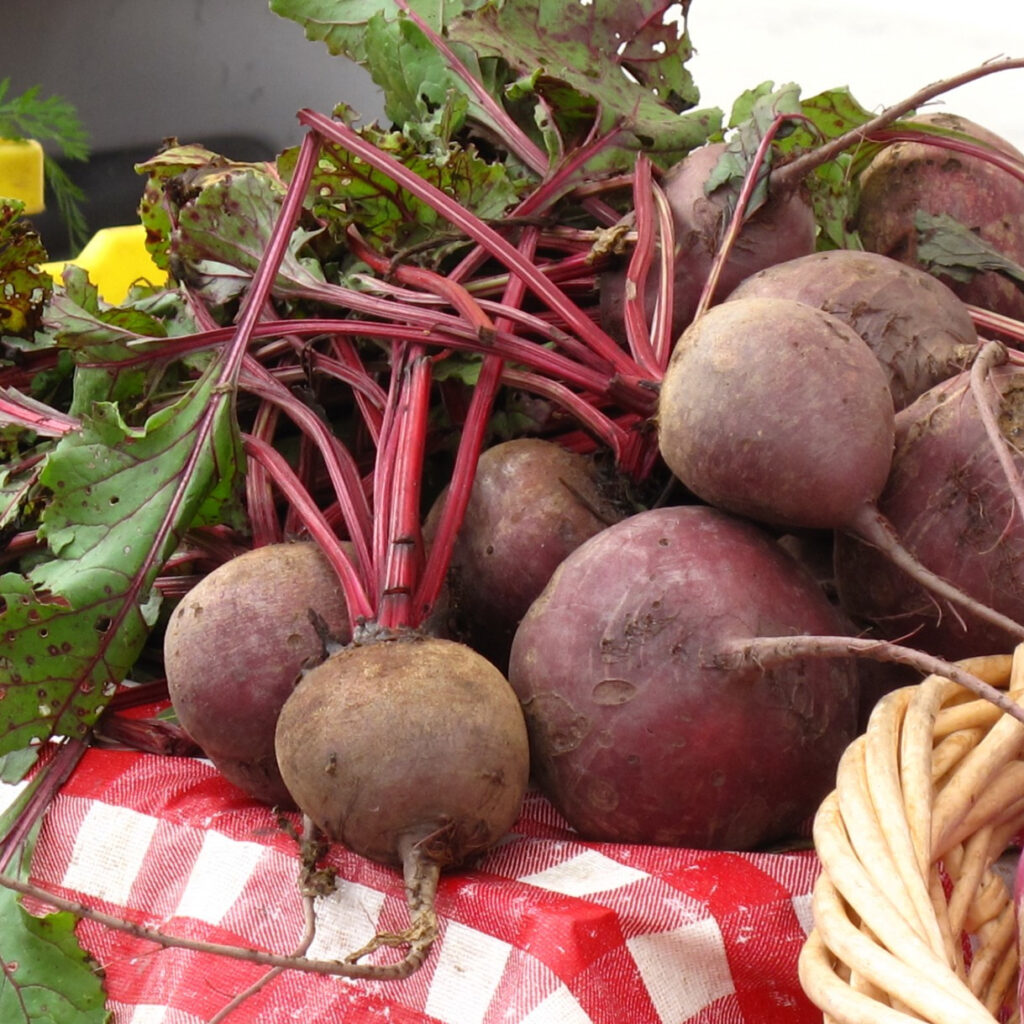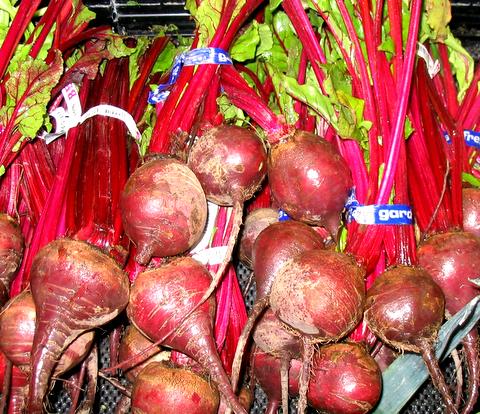Where to Grow Beets
Beets are an annual cool-season crop, half-hardy to frost and light freezes. They thrive in all parts of the country. Beets are closely related to spinach and chard, and once called “blood turnips” because of their bright red juice. Growing beets will provide delicious colorful roots and nutritious greens. Most beets are open-pollinated and multi-germ, where one seed yields a clump of 4-5 plants that need to be thinned. These “seed balls” germinate better if soaked an hour before planting.
Beet Varieties
Yellow and white beets tend to be sweeter than red varieties, and the best beets to use with other roasted vegetables because they don’t bleed red juice. Storage beets are beet varieties that excel when grown for fall harvest followed by winter storage in the refrigerator or root cellar. Newer hybrids are usually sweeter than older varieties and offer more green leaves. Most beets contain 5-8% sugar, where newer hybrids such as Big Red run 12-14%. There are also some special varieties of forage or mangel-wurzel beets that are typically fed to livestock, whose roots can weigh as much as 20 pounds each. In general search for varieties that are resistant to bolting and downy mildew. Beets tend to get tough, woody, and develop an off-flavor in hot weather, so plan on harvesting in early summer or fall. If you have hot summers, choose a variety that matures in 45-60 days.
Recommended varieties:
Detroit Dark Red; Early Wonder; Ruby Queen; Firechief; Burpee’s Golden, an unusual beet with sweet golden flesh that does not bleed when cooked; Long Season, a slow-growing long beet, roughly shaped and harvested in early fall or for winter storage.
Soil for Beets
Beets grow well in average garden soil. The best crop is achieved with pH 6.5 in a rich, sandy loam prepared with well-rotted manure and compost to a depth of 8 inches. Beets do not thrive if the pH is below 5.8. The soil should be well pulverized to remove stones and clods so that roots form well and rapidly.

| Temperature | |
| Germination | 50 - 85 F |
| For growth | 60 - 65 F |
| Soil and Water | |
| Fertilizer | Heavy feeder, needs high P, avoid high N. Good tops may mean roots are poorly developed and the plant is getting too much N. |
| Side-dressing | Every 2 weeks provide a light and balanced feeding; when tops are 4-5" use low N. |
| pH | 5.8 - 7.0 |
| Water | Average |
| Measurements | |
| Seed Planting Depth | 1/4" |
| Root Depth | 24" - 10' |
| Height | 12" |
| Width | 4 - 8" |
| Space between plants | |
| In Beds | 3 - 4" |
| In Rows | 6" |
| Space Between Rows | 18 - 24" |
| Average plants per person | 10 - 20 |
| Harvest | |
| In late June, or before hot season enters its prime, scrape some soil away from the beets to check their size.Pull the beets when they are 1-2" across. | |
| First Seed Starting Date: | 14 - 28 Days before last frost date |
| Last Seed Starting Date: | 74 - 104 Days before first frost date |
| Companions | |
| Companions | All brassicas, bush beans, head lettuce. |
| Incompatibles | Field mustard, all pole beans. |
Planting Beets
Germination should occur in 5 to 10 days if seeds are kept sufficiently moist. Plan on an average of 10-20 plants per person.
When –
Beets are hardy and may be sown as soon as the ground can be worked. Beet seeds can germinate in cool soil, but they sprout best when soil temperatures are above 50 degrees Fahrenheit. They should be planted directly in the garden one month before your last spring frost. For succession crops, plantings can be made every 2 weeks to mid-summer. Beets can become tough and stringy if grown in hot weather during droughts; ample water supply is essential to succulent roots. A late summer crop can be sown for fall harvest, start planting them 10 to 12 weeks before the last fall frost.
How –
Sow seed 1/2 inch deep in rows 12-18 inches apart. The beet seed is a compact ball of many tiny seeds. Many plants germinate where each seed is sown, so seed should be placed sparingly. When seedlings are 4-6 inches high, thin plants to stand 1 1/2 inches apart. (They can be used in salad or cooked as spinach.) Then, as these beets grow to about an inch in diameter, pull every other one to allow larger beets to grow.
How Beets Grow
Red table beets develop leaves with red stems and leaf veins similar to red-leafed chard varieties. The leaves can be used as a spinach substitute. Beets grow best when temperatures average 65 degrees, so early plantings will grow faster if covered with a row cover. Beetroots naturally push up out of the ground as they mature, and this exposed portion of the beet can cause the shoulders of white or yellow beets to become green and tough and should be mulched to avoid this problem. Beets will typically produce edible greens in 35 days, followed by cylindrical roots a month later.
Cultivation for Beets
The rows should be cultivated shallowly halfway through growth periods to keep weeds down, or the rows may be heavily mulched to keep them weed-free. Initial plantings will need to be thinned, because of the multiple plants that grow from one seed. An additional thinning when the roots reach a diameter of 1 inch to a spacing of 4 inches between plants will enable the roots to reach their full potential size.
| Storage Requirements | ||
|---|---|---|
| Remove all top greens, leaving about 1" of stem with the beet. Do NOT wash. Pack beets in straw or moist sand. Beets can also be left in ground and dug up under the snow. | ||
| Fresh | ||
| Temperature | Humidity | Storage Life |
| 32 F | 98 - 100% | 4 - 7 months topped; 14 days bunched |
| Preserved | ||
| Method | Taste | Shelf Life |
| Canned | Good | 12+ months |
| Frozen | Fair | 8 months |
| Dried | Fair | 12+ months |
Harvesting Beets
Beets should be ready to harvest within 60 days of planting. Harvesting beets is really a matter of preference when it comes to the right size for harvesting. They are ready any time after you see the shoulder protruding at the soil line. Picking a leaf or two from each plant won’t compromise their root growth significantly, but many gardeners prefer to wait until the beet is ready to harvest to pick the inner leaves. Beet leaves taste best when they are about 6 inches long, but baby greens are wonderful in salads and bigger leaves still cook up nicely. Carefully wash harvested beets in cool water, use a sharp knife to cut off all but 1 inch of the beet tops, but leave the taproot intact. Removing the tops will prevent moisture loss while in storage. Store washed, trimmed beets in your refrigerator, or root cellar for several months.
Pests for Beets
None of major concern.
Diseases for Beets
None of major concern
